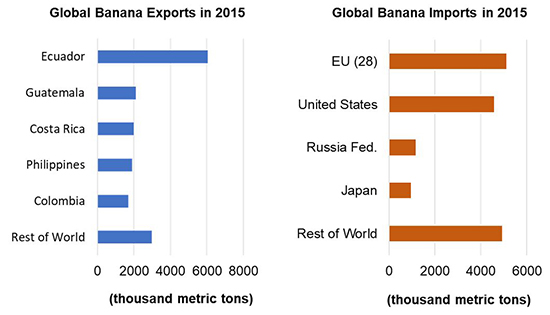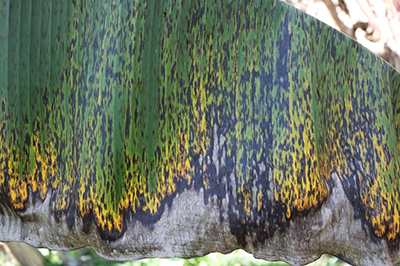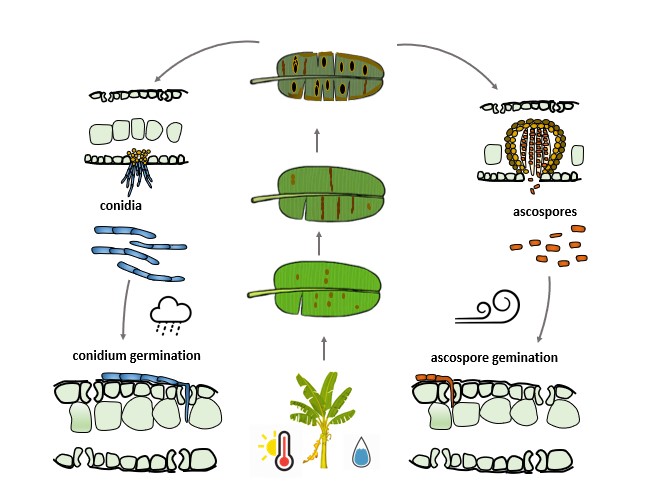Background Information
Bananas are grown in more than 130 countries across the tropics and subtropics and are ranked as the fourth most important food crop after rice, wheat, and maize. Most banana fruits are produced for local markets as an important staple food in many countries. International trade of bananas represents an annual production of 14.3 million tons with a value of over $8.9 billion. About two thirds of exported bananas are grown in Latin America, including Ecuador, Costa Rica, and Guatemala (Figure 1). Multinational companies play a dominant role in purchasing fruits from these banana-producing countries and supplying the importing countries. The United States is the largest single-country importer, accounting for 27% of the total global import volume in 2015 (Figure 1). The banana export market is highly competitive, as many companies seek to increase their market shares by offering low prices at retail sale.

Figure 1. World's top exporters and importers of bananas, 2015 [Source: Food and Agriculture Organization of the United Nations]
|
Disease background
Most exported bananas come from a single cultivar, Cavendish. These bananas are sterile, which means they are seedless and are therefore more pleasant to eat than other types of bananas, many of which have hard black seeds. Cavendish has gained its popularity in the export market because it is consistently tasty, achieves the right size for packing into boxes, and survives weeks in shipping. But the superior performance of the Cavendish banana comes at a cost. For one thing, this cultivar is highly susceptible to black Sigatoka, a disease of the leaves caused by the fungus
Pseudocercospora fijiensis. Furthermore, since all plants in a plantation are genetically identical – also known as a monoculture – all the plants are vulnerable to black Sigatoka.
Black Sigatoka was first detected in the Sigatoka Valley on the Fiji Islands in the 1960s and reached Honduras in the western hemisphere in the 1970s. Since then, it has spread throughout Central America, where the banana industry expanded and intensive international trade developed. Infected plants show severe damage to leaves, resulting in significant defoliation and loss of marketable yield. Once the fungus becomes established in a plantation, it is almost impossible to eradicate.
Currently, this disease is controllable only with frequent applications of fungicides to achieve profitable production. The heavy use of fungicides not only imposes hazards to the environment and human health, but also selects for fungicide-resistant strains of
P. fijiensis, which can lead to a vicious cycle of increasingly intensive fungicide applications.
Symptoms and signs
Early black Sigatoka symptoms can be small chlorotic specks that appear on the underside of the 3rd or 4th open leaf. As they develop, these specks grow into brown linear streaks that run parallel to the leaf veins (Figure 2). The streaks appear first on the lower side of a leaf, then on both sides. The streaks get longer, forming spindle-shaped or elliptical spots. Large areas of the affected leaf turn brown, with black spots surrounded by yellow haloes. Eventually, severe infection causes large areas of leaf to turn necrotic, which can lead to complete collapse of leaf surface (Figure 3). Significant loss in functional leaf area causes reduction in yield and uneven ripening of fruit, which makes them unsuitable for export.

Figure 2. A banana leaf (cv. Cavendish) showing early symptoms of black Sigatoka. (Courtesy M. Guzman)
| 
Figure 3. A banana leaf (cv. Cavendish) showing severe symptoms of black Sigatoka (Courtesy M. Guzman)
|
Disease cycle

Figure 4. Disease cycle of Pseudocercospora fijiensis on banana and the development of symptoms.
|
The disease cycle of black Sigatoka starts with germination of spores of
Pseudocercospora fijiensis, followed by penetration of the leaf stomata and development of visible symptoms on the leaves. The production of new spores continues with additional rounds of infection (Figure 4). The black Sigatoka fungus produces two types of spores; the asexual spores are called conidia and the sexual spores are called ascospores. Both conidia and ascospores can infect banana leaves under conditions of high humidity.
Conidia are produced at early phases of the disease. They are formed in high humidity and dispersed over short distances by splashing of rain and irrigation water, causing local spread of the disease. Conidia also germinate under high humidity, especially in the presence of a water film on leaves. Conidia infect the leaf through stomata (structures on the leaf surface that allow for gas exchange). Hyphae (filaments) of the black Sigatoka fungus can emerge from a stomate, then grow along the leaf surface and penetrate neighboring stomata, which spreads the infection and worsens the development of symptoms.
Ascospores are produced at later stages of the disease and are spread by wind, allowing them to be dispersed longer distances than conidia. Wet leaf surfaces favor the maturation of ascospores, which are released from the leaf surface and spread by means of air currents. The use of infected banana leaves as packing material for shipping fruit has also provided a source of inoculum for long-distance migration of the disease.
Chemical controls
Fungicidal control of black Sigatoka is the most effective way to suppress the fungus. Two types of fungicides are commonly used: contact fungicides (e.g., mancozeb and chlorothalonil) and systemic fungicides (e.g., benomyl, propiconazole, and azoxystrobin). Contact fungicides do not penetrate the leaf tissue after application, but instead as a chemical barrier on the leaf surface to protect against infection. Because they deteriorate rapidly on the leaves once they are applied, contact fungicides must be re-applied relatively frequently. Systemic fungicides, on the other hand, are absorbed into the plant. Unlike contact fungicides, systemic fungicides can be used to suppress the development of symptoms after they first appear. This mode of action allows the frequency of spraying to be reduced compared to contact fungicides – but only if the systemic fungicides remain effective against the fungus. The weakness of many systemic fungicides is that the black Sigatoka fungus can readily develop resistance to them – unlike the contact fungicides, which are less prone to resistance development.
Breeding for resistance
Developing a disease-resistant Cavendish banana or a replacement banana cultivar would be a long-term solution for black Sigatoka control in export banana plantations.
Conventional breeding. It is difficult to genetically improve Cavendish because most cultivated bananas are effectively sterile. They are triploids with 11 chromosomes in each set, which means they have three copies of each chromosome. Triploids cannot undergo normal pairing at meiosis, giving rise to gametes with an incomplete set of chromosomes. These gametes will not lead to viable progeny, which is the reason why the bananas we eat have no seeds. Wild bananas, on the other hand, are diploids with two sets of chromosomes, and they do have seeds. They are widely used as male parents in conventional breeding as sources to introduce disease resistance. For example, Calcutta 4 is a wild banana variety that is resistant to black Sigatoka. However, it has a small fruit bunch, contains seeds in the fruits, and is inedible (Figure 5). Breeders have been trying to cross Calcutta 4 with different varieties to produce resistant hybrids with improved agronomic qualities such as larger bunches and better eating quality. New hybrids that meet the high standards of the export trade have not yet been developed. On one hand, new cultivars should resist diverse populations of the black Sigatoka fungus as well as other important banana diseases and pests such as Panama disease, yellow Sigatoka disease, and nematodes. On the other hand, the new resistant cultivars would also need to have high yield, good fruit quality, and long post-harvest shelf life to replace the Cavendish cultivar. Also, the high level of genetic diversity in
Pseudocercospora fijiensis allows the fungus to adapt rapidly to new resistant host genotypes, potentially limiting the usefulness of disease-resistant cultivars.

|
| Figure 5. The bunch and fruit features of Calcutta 4, a cultivar resistant to black Sigatoka. Note the presence of large, black seeds in the fruit. (Courtesy M. Guzman) |
Genetic engineering. Genetic engineering can be applied to add genes for disease resistance to the desirable cultivar Cavendish. To understand which genes are responsible for the pathogen's ability to attack bananas, scientists have been working on understanding the genome (i.e., the full complement of genes in an organism) and evolution of
P. fijiensis. The success of genetic modification depends on the deployment of resistance genes and the development of efficient plant transformation systems. Cells carrying the targeted resistance genes can be selected and induced to form embryos that regenerate as resistant transgenic plants. However, the transgenic plants with disease resistance may face regulatory barriers in countries that are skeptical about genetically modified crops. Applying new genome-editing technologies has the potential to create genetically modified Cavendish cultivars with durable resistance to black Sigatoka by rearranging their own genes rather than adding genes from other plant species.
